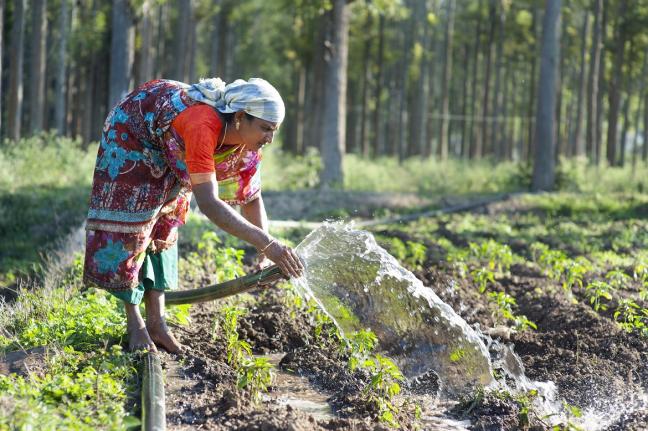Mainstreaming Climate Resilience: The MGNREGA Model
by , e -
The Mahatma Gandhi National Rural Employment Guarantee Act (MGNREGA) is India’s flagship scheme serving as a social security net for millions of rural households; providing them guaranteed employment and income resilience. While it has contributed significantly to the rural life and economy, can it be used to mainstream climate agendas into development, and contribute to building resilience?
A model of convergence
Climate resilience is understanding how climate change – both slow-onset events (such as increasing sea levels, rising temperature, rapidly changing weather patterns, etc.) and extreme events, translate into real risks that affect our wellbeing,) and taking actions to better cope with these risks. These could be many — such as a drop in agricultural productivity, loss and damage to physical assets etc. These require decentralized planning to address specific climate risks faced by local communities.
MGNREGA is implemented on similar principles. It focuses on the vulnerable population and follows a bottom-up approach from the stage of planning to approval. There are 260 combinations of work that are permissible under MGNREGA of which 181 are associated with natural resources management and 164 are related to agriculture and allied activities. Most of these works are critical from the perspective of climate resilience.
Another key aspect is financing. MGNREGA attracts huge funding from the Government of India. In the current year, the scheme has been allocated INR 61,000 crore for implementation across the country. This addresses one of the key challenges, as well as an opportunity for building climate resilience – lack of investments. As per the Global Commission on Adaptation (GCA), return on investments in improved resilience is high with benefits with benefit-cost ratios ranging from 2:1 to 10:1. Despite these benefits, money is not flowing at required pace or scale. Given that 70% of India’s population still lives in rural areas, MGNREGA can help the transition to climate resilient development in India in a cost-effective manner.
Case Study: Sikkim’s Dhara Vikas Project
One of the successful examples of this is in the state of Sikkim, where the Rural Development Department (RDD) has used MGNREGA and funding from the National Adaptation Fund for Climate Change (NAFCC) to implement the Dhara Vikas Project in 2008. In implementation since 2008, it is an innovative program to enhance water security and rejuvenate springs in the drought prone areas of Sikkim. Around 80% of Sikkim’s rural households are dependent on springs for drinking water and irrigation and were under pressure due to declining groundwater level and drying water bodies. The program uses both local expertise and scientific GIS techniques to identify recharge areas for these springs. The local labor routed through MGNREGA are used for a variety of conservation activities like laying contour trenches, rainwater harvesting, expanding minor irrigation networks, etc. Such activities contribute to enhancing water percolation rates and checking surface run-off, improving ground water levels and providing more water security to the communities.
The Dhara Vikas convergence model is an excellent example of how MGNREGA can be used effectively to mainstream climate resilience and adaptation into development, by contributing to overall income and livelihood opportunities for the vulnerable. In encouraging local participation, the program also ensures development of knowledge and skills at the community level.
The missing element: use of climate data and risk management strategies
Mainstreaming climate resilience into MGNREGA requires integration of climate information, adoption of low-carbon technologies and creation of resilient infrastructure. Unlike State Action Plans for Climate Change (SAPCCs) which are driven from the top, the bottom-up structure of MGNREGA requires large-scale awareness and capacity building of gram and block panchayats on the effects of climate change on their livelihood and well-being. This task is challenging because it involves breaking complex and scientific climate change data into information which can be understood and acted upon by local communities. It will also involve multiple institutional changes such as new guidelines for project design and accommodating the extra costs of using low carbon technologies and making infrastructure more climate resilient. If MGNREGA is able to convert these challenges into opportunities, it can be a very useful tool to aid India’s efforts towards building a more resilient future and enhance the adaptive capacity of its most vulnerable population.
WRI India’s Climate Resilience Practice (CRP) team is collaborating with the Climate Action Network South Asia (CANSA) to work in three states — Sikkim, Madhya Pradesh and Tamil Nadu, with the objective of mainstreaming resilience into district level planning processes, and enhance the capacity of the states to mobilize climate finance through a series of workshops and consultations. The lessons gleaned from the Dhara Vikas program offer great insights to the team’s efforts — to focus on strengthening local institutional capacities and stakeholders, and to promote a convergence model that can integrate both developmental and climate concerns. The hope is that states can replicate such initiatives as well as come up with novel solutions to address the most pressing climate vulnerabilities that they are facing. Knowledge sharing of best practices and experiences, such as this one, will continue to remain an important component of this exercise.
Nakul Sharma is Policy Coordinator at Climate Action Network South Asia (CANSA).


